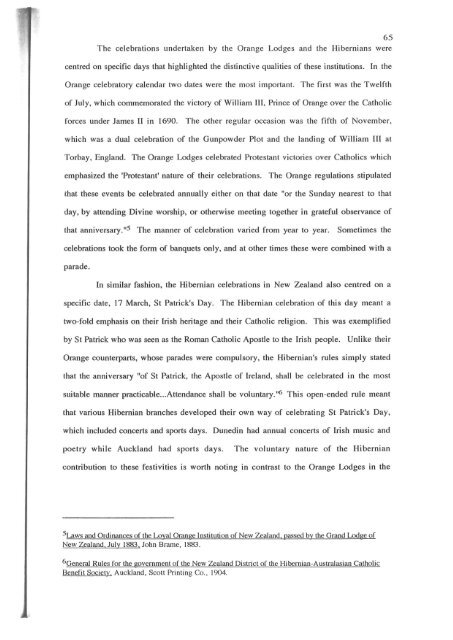TRANSPLANTED IRISH INSTITUTIONS - University of Canterbury
TRANSPLANTED IRISH INSTITUTIONS - University of Canterbury
TRANSPLANTED IRISH INSTITUTIONS - University of Canterbury
Create successful ePaper yourself
Turn your PDF publications into a flip-book with our unique Google optimized e-Paper software.
65<br />
The celebrations undertaken by the Orange Lodges and the Hibernians were<br />
centred on specific days that highlighted the distinctive qualities <strong>of</strong> these institutions. In the<br />
Orange celebratory calendar two dates were the most important. The first was the Twelfth<br />
<strong>of</strong> July, which commemorated the victory <strong>of</strong> William III, Prince <strong>of</strong> Orange over the Catholic<br />
forces under James II in 1690. The other regular occasion was the fifth <strong>of</strong> November,<br />
which was a dual celebration <strong>of</strong> the Gunpowder Plot and the landing <strong>of</strong> William III at<br />
Torbay, England. The Orange Lodges celebrated Protestant victories over Catholics which<br />
emphasized the 'Protestant' nature <strong>of</strong> their celebrations. The Orange regulations stipulated<br />
that these events be celebrated annually either on that date "or the Sunday nearest to that<br />
day, by attending Divine worship, or otherwise meeting together in grateful observance <strong>of</strong><br />
that anniversary.,,5 The manner <strong>of</strong> celebration varied from year to year.<br />
Sometimes the<br />
celebrations took the fonn <strong>of</strong> banquets only, and at other times these were combined with a<br />
parade.<br />
In similar fashion, the Hibernian celebrations in New Zealand also centred on a<br />
specific date, 17 March, St Patrick's Day. The Hibernian celebration <strong>of</strong> this day meant a<br />
two-fold emphasis on their Irish heritage and their Catholic religion. This was exemplified<br />
by St Patrick who was seen as the Roman Catholic Apostle to the Irish people. Unlike their<br />
Orange counterparts, whose parades were compulsory, the Hibernian's rules simply stated<br />
that the anniversary "<strong>of</strong> St Patrick, the Apostle <strong>of</strong> Ireland, shall be celebrated in the most<br />
suitable manner practicable ... Attendance shall be voluntary."6 This open-ended rule meant<br />
that various Hibernian branches developed their own way <strong>of</strong> celebrating St Patrick's Day,<br />
which included concerts and sports days. Dunedin had annual concerts <strong>of</strong> Irish music and<br />
poetry while Auckland had sports days.<br />
The voluntary nature <strong>of</strong> the Hibernian<br />
contribution to these festivities is worth noting in contrast to the Orange Lodges in the<br />
5Laws and Ordinances <strong>of</strong> the Loyal Orange Institution <strong>of</strong> New Zealand, passed by the Orand Lodge <strong>of</strong><br />
New Zealand, July 1883, John Brame, 1883.<br />
60eneral Rules for the government <strong>of</strong> the New Zealand District <strong>of</strong> the Hibernian-Australasian Catholic<br />
Benefit Society, Auckland, Scott Printing Co., 1904.
















